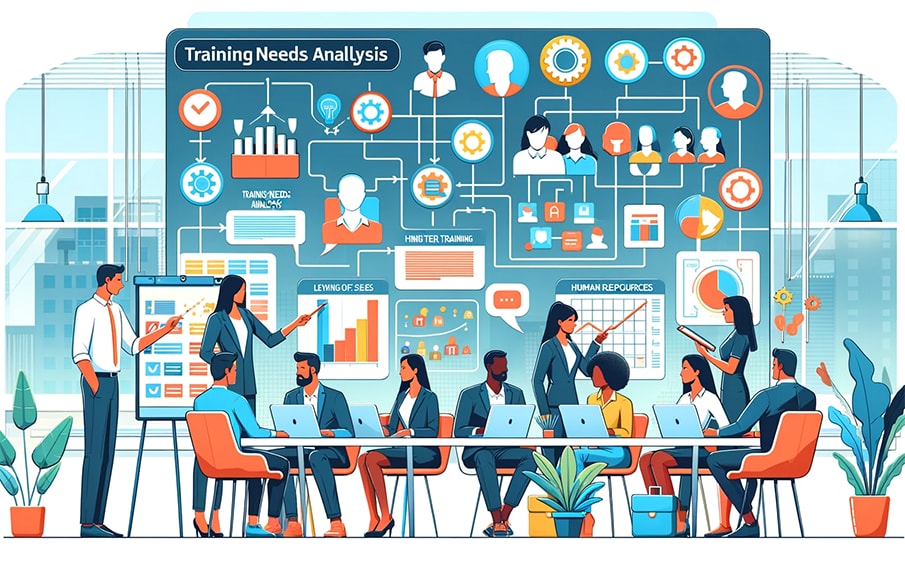As a key player in your organization’s success, you’ve probably asked, “What is a training needs analysis?” You might have heard this term tossed around in management meetings or read it in HR handbooks. But what exactly does it mean? And more importantly, how can it help improve your employees’ performance and, ultimately, your business’ bottom line?
In this guide, we’ll dissect the concept of training needs analysis, its relevance in an organization, and how it impacts employee performance and business operations. Let’s delve right in!

What is a Training Needs Analysis
Training needs analysis (TNA) is a systematic process of identifying the training and development needs of your employees in line with your company’s strategic goals. It provides a structured approach to identify any skill gaps or performance deficits and then suggests training interventions that can address these identified areas.
Like a physician diagnosing a patient’s condition before prescribing medicine, a TNA examines your workforce to identify the areas where training can enhance their productivity and efficiency.
Unraveling the Meaning of Training Needs Analysis
So, why is understanding the training needs analysis (meaning of training needs analysis) crucial? Let’s liken this to constructing a building. Before you start building, you need a blueprint, right? A TNA serves as that blueprint, detailing the existing skills and knowledge of your employees and identifying where they require improvement or development.
This is a proactive approach to ensure that your staff is competent, efficient, and in tune with the evolving business landscape. It’s not just about patching up the cracks but also fortifying the structure of your workforce to stand strong amidst future challenges.
Benefits of Training Needs Analysis
A well-executed training needs analysis carries several benefits:
- Enhanced productivity: By identifying skills gaps and delivering targeted training, you can boost individual and team productivity.
- Increased employee engagement: Employees are more likely to be engaged when they feel supported in their career development.
- Improved retention: Training and development opportunities increase job satisfaction, which can lead to higher retention rates.
- Better use of resources: By focusing on identified needs, organizations can avoid wasting resources on unnecessary training.
- Risk mitigation: Training employees to handle potential risks can prevent costly mistakes and workplace accidents.
The Process of an organizational training needs analysis
Conducting a training needs analysis involves several steps. Let’s break it down:
- Identify business objectives: Start by defining your organization’s strategic goals and objectives. This provides the direction for your TNA.
- Identify the necessary skills: Determine the skills and knowledge needed to meet these objectives.
- Assess current skills: Evaluate the current skills, knowledge, and abilities of your employees. This can be done through performance reviews, surveys, or direct observation.
- Identify gaps: Compare the required skills against the current skills to identify gaps.
- Create a training plan: Design a plan to bridge these gaps through targeted training and development programs.
- Implement the training: Execute the training plan, making sure to cater to different learning styles and preferences.
- Evaluate the effectiveness: After the training, assess its effectiveness by monitoring changes in performance, productivity, and employee engagement.
Training Needs Analysis Example with Andragogical Insights
Imagine you run a tech company and you’ve noticed that many customer complaints stem from delays in problem-solving. A training needs analysis, grounded in the principles of andragogy, might reveal that your customer service team lacks adequate technical knowledge. As a result, they struggle to resolve technical issues efficiently, highlighting a gap in their adult learning process.
Armed with this knowledge, you could then develop targeted training, informed by andragogical strategies, to upskill your customer service team in the required technical areas.
The Role of E-Learning in Training Needs Analysis
In today’s digital age, e-learning platforms have become a popular medium for training needs analysis. Online assessments, e-learning modules, and digital performance tracking tools provide rich data about employees’ skills and knowledge.
E-learning platforms are flexible, accessible, and can deliver training content tailored to individual needs. These platforms provide a powerful tool for businesses to meet the training and development needs of their workforce efficiently and effectively.
Conclusion
Understanding the needs analysis (training needs analysis) for employees is not just a managerial fad—it’s an essential strategic approach for any business aiming to nurture a competent, efficient, and adaptive workforce. It allows your organization to make informed decisions about employee development, enhancing productivity, and, ultimately, boosting your bottom line.
As the business world continues to evolve rapidly, staying ahead means not just reacting to changes but also proactively preparing for them. And that’s exactly what a robust training needs analysis enables you to do. So, are you ready to bridge the skill gaps and build a stronger, more resilient workforce?


